Channa pleuropthalma
Ocellated Snakehead
SynonymsTop ↑
Ophicephalus pleurophthalmus Bleeker, 1851; Ophicephalus urophthalmus Bleeker, 1852
Etymology
Channa: from the Latin channe, used to refer to an unspecified species of sea perch.
pleuropthalma: from the Ancient Greek πλευρά (plevrá), meaning ‘side’, and ὀφθαλμός (ophthalmós), meaning ‘eye’, presumably in reference to the series of ocellated spots present on the flanks of this species.
Classification
Order: Perciformes Family: Channidae
Distribution
Native to southeastern Sumatra plus the Kapuas and Barito river basins of Kalimantan, Indonesian Borneo.
Type locality is ‘Bandjarmasin, Borneo, Indonesia’.
Habitat
Streams and mangroves.
Maximum Standard Length
300 – 350 mm.
Aquarium SizeTop ↑
An aquarium with base measuring at least 240 ∗ 60 cm is recommended.
Maintenance
Relatively unfussy although some surface cover in the form of floating or overhanging vegetation or branches is appreciated. Unlike most Channa spp. it is pelagic and requires plenty of room to swim.
It is essential to use a tightly-fitting hood since Channa spp. are notorious for their ability to escape, and a gap should be left between this and the water surface as they require access to a layer of humid air.
Young individuals are extremely sensitive to water changes and do not require regular maintenance.
Water Conditions
Temperature: 22 – 28 °C
pH: 6.0 – 7.5
Hardness: 36 – 215 ppm
Diet
An obligate predator which probably feeds on smaller fishes, amphibians and terrestrial insects in nature, but in most cases adapts well to dead alternatives in captivity.
Some specimens even accept dried foods though these should never form the staple diet.
Young fish can be offered chironomid larvae (bloodworm), small earthworms, chopped prawn and suchlike, while adults will accept strips of fish flesh, whole prawns/shrimp, mussels, etc.
This species should not be fed mammalian or avian meat such as beef heart or chicken since some of the lipids contained in these cannot be properly metabolised by the fish, and may cause excess fat deposits and even organ degeneration.
Similarly, there is no benefit in the use of ‘feeder’ fish such as livebearers or small goldfish which carry with them the risk of parasite or disease introduction, and at any rate tend not have a high nutritional value unless properly conditioned beforehand.
Behaviour and CompatibilityTop ↑
C. pleurophthalma is among the few snakeheads known to form aggregations throughout its lifetime, but is still best-maintained in a species-specific aquarium.
Although generally a shy and wary species, it may become bold and attempt to attack tankmates if maintained in a conspecific group. Any fish small enough to be considered prey will be damaged or eaten.
Sexual Dimorphism
Sexually mature males are more slender than females, plus males tend to develop a bluish colour pattern and females greenish.
Reproduction
Unrecorded. In nature, this species forms aggregations in open rivers and only forms temporary pairs during the reproductive period, which split from the main group to spawn in marginal vegetation before returning. Presumably there is no parental care.
NotesTop ↑
This species may also be seen referred to as ‘orange-spotted snakehead’.
Members of the family Channidae are commonly referred to as ‘snakeheads’ due to possession of large scales on the head of most species which are reminiscent of the epidermal scales (cephalic plates) on the heads of snakes.
There currently exist over 30 valid species but diversity within the group is likely to prove significantly greater.
Species from northeastern India were divided into the C. marulius and C. gachua groups by Vishwanath and Geetakumari (2009).
C. marulius is included in the former assemblage which the authors characterise by possessing the following combination of characters: a prominent V-shaped sharp isthmus; cephalic sensory pores arranged in groups; absence of scales on the lower jaw; a sharp, prominent, spinelike hypurapophysis; more branchial than epibranchial toothplates; an elongate urostyle.
All Channa spp. posses-s supplementary breathing apparatus in the form of paired suprabranchial chambers located behind and above the gills, although these are not labyrinthic but lined with respiratory epithelium.
These chambers allow the fish to breathe atmospheric air and survive in hypoxic conditions or even out of the water for a considerable period of time, and in aquaria they are often seen rising to the surface to take gulps of air.
References
- Bleeker, P., 1851 - Natuurkundig Tijdschrift voor Nederlandsch Indië v. 1: 259-275
Nieuwe bijdrage tot de kennis der ichthyologische fauna van Borneo met beschrijving van eenige nieuwe soorten van zoetwatervisschen. - Brede, N. and P. Antler, 2009 - Natur und Tier Verlag, Münster: 1-62
Schlangenkopffische—Die Gattungen Channa und Parachanna. - Courtenay, W. R., Jr. and J. D. Williams, 2004 - Circular, U. S. Department of the Interior, Geological Survey No. 1251: i-v + 1-143
Snakeheads (Pisces, Channidae) - a biological synopsis and risk assessment. - Tan, H. H. and P. K. L. Ng, 2005 - The Raffles Bulletin of Zoology Supplement 13: 115-138
The labyrinth fishes (Teleostei: Anabanatoidei, Channoidei) of Sumatra, Indonesia.

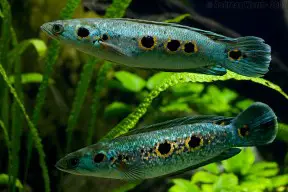
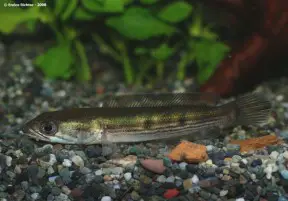
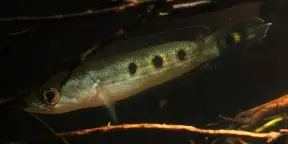
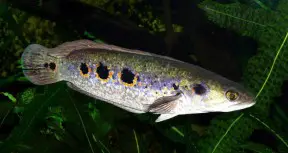
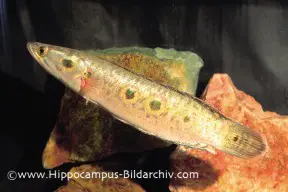

May 10th, 2015 at 11:23 am
This species doesn’t seem to have any information on it, maybe the author could update with this information:
Channa Pleuropthalma (Ocellated or Orange Spotted Snakehead)
Classification: Order: Perciformes Family: Channidae
Distribution: Southeastern Sumatra; Kapuas and Barito basins of Kalimantan
Habitat: Streams and Mangroves
Maximum Standard Length: 16 inches
Aquarium Size: 2 feet would suffice for one specimen, larger tank required if keeping a group.
Maintenance: Cover should be provided as this fish is quite shy.
A tight fitting lid is a must have as all Channa Sp. are notorious for their ability to escape.
Water Conditions:
Temperature: 22-28°C
pH: 6.0-7.5
Hardness: 36-357 ppm
Diet:
Being a carnivore, Channa Pleuropthalma should be fed a variety of meaty foods, live or dead. These fish are also known to be able to take commercial carnivore pellets.
Behaviour and Compatibility:
Channa Pleuropthalma is among the few snakeheads known to continue to live in packs even after during adulthood.
A shy and wary species, these fish have been known to get along with much larger fish, however if kept in a group they may be bold and attempt to attack tankmates. Do not try to mix them with fish they can fit in their mouths, they will see them as prey.
Sexual Dimorphism:
Once sexually matured, the fish’s genders can be distinguished. Males are more slender than females, and also males tend to develop a blue shade whilst females retain the same green coloration on the body.
Reproduction: Not documented, but could be achieved in a large enough tank set up correctly. A setup that could be successful would be a very long and wide tank, with a shallow region, heavily planted. In nature, they swim in the open rivers in packs and when the breeding season arrives a pair swims into the shallows which are covered in plants, they spawn in the plants and are thought to then return to the group.
Notes:
The young of this fish are extremely sensitive to water changes. Do not perform very frequent water changes as these will stress them greatly.
Regarding pack hunting, these fish are very efficient. As soon as one member launches an attack, the otgers will follow suite. Therefore, consider tankmates for these fish before mixing them in together.
I hope that this information will benefit those who wish to keep this amazing species.
May 19th, 2015 at 9:08 pm
Hi groversenpai, thanks a lot for the feedback, and I’ve added some text based largely on yours. A question regarding the behaviour of the wild fish – is this from personal observation or is there a reference somewhere?
Thanks again!